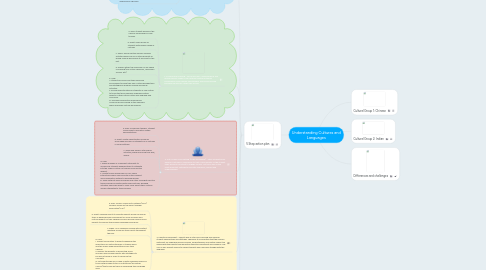
1. Cultural Group 1: Chinese
2. Cultural Group 2: Indian
3. Differences and challenges
4. 5 Step action plan
4.1. 1. Cultural integration to curricula – to promote cultural diversity, it needs to be explicitly included in the learning that the students engage in.
4.1.1. a. Who: HODs and Teachers
4.1.2. b. What: Design the curriculum in such a way so as to promote social inclusion, understanding, and mutual respect.
4.1.3. c. When: At the beginning of the academic year and throughout the year the planning and adaptation of the curriculum needs to be done before and after each unit.
4.1.4. d. Where: The objectives and goals for each unit should be documented in an easily accessible platform such as “Atlas” or e-folio for reference.
4.1.5. e. How: i. Clear avenues where multiculturalism is integrated into the unit needs to be set into place. Eg. It can be added as a transitional topic at the end of a unit but would be best served as an essential aspect rather than a supplement. ii. Unit should be able to be linked to various social contexts iii. Learning activities should expect students to investigate own cultural perspectives and compare them to those of a different culture. Eg: Native Indian student learns about Chinese perspectives and vice versa. iv. The topics should also be addressed in advisory.
4.2. 2. Collaborative learning – social inclusion, understanding, and mutual respect needs to be fostered through authentic collaborative means where the attitudes and values develop and become intrinsic rather than forced.
4.2.1. a. Who: student groups in the class as prescribed by class teacher
4.2.2. b. What: small groups of students with diverse range of cultures
4.2.3. c. When: During certain specific learning activities which call for cultural diversity or during a group discussion at any point in the unit.
4.2.4. d. Where: within the classroom or any space of learning (Eg: virtual classroom, discussion forums. Etc)
4.2.5. e. How: i. Students of various cultures should be encouraged to bring their own cultural perspectives and strategies in problem solving and group activities. ii. Provide opportunities for students of one culture to teach the team members regarding certain aspects of their native culture and language and vice versa. iii. Through collaborative learning find common ground among all the members which surpasses cultural boundaries.
4.3. 3. Out of class social setting (clubs and groups) - often students from different cultures in comparison to that of the majority of the student body would be reluctant to engage socially. Yet this is one of the most important settings to facilitate tolerance, respect and understanding.
4.3.1. a. Who: Homeroom teacher, Student Government Association Grade representatives
4.3.2. b. What: create opportunities as well as encourage inclusion of students of all cultures in social settings.
4.3.3. c. When and Where: after school activities, break and lunch time play, WWW.
4.3.4. d. How: i. Assign buddies of a different nationality to socially shy students enabling them to integrate into the ‘school culture’ of tolerance and mutual respect. ii. Create teams during play for non-verbal interactions which can promote mutual respect and collaboration without a language barrier. iii. Week Without Walls groupings and other overnight field trip teams should be oriented with mixed cultures. Bridging activities should be done to learn more about other cultures and be integrated to team building.
4.4. 4. Parental involvement – Parents play a vital role in forming and molding student perspectives and attitudes. Therefore it is imperative that the school’s sentiment for upholding social inclusion, understanding, and mutual respect be shared with the parents through active parental involvement and influence. The SCN is also a great avenue to support parents who may able struggle with the language.
4.4.1. a. Who: School Community Network (SCN) formerly known as the Parent Teacher Association (PTA).
4.4.2. b. What: organize events to educate parents as well as involve them in developing an environment of social inclusion and mutual respect for their children and also provide resources for parents to improve their English language proficiency.
4.4.3. c. When: SCN organized Coffee with content meetings as well as other events throughout the year.
4.4.4. d. How: i. Present information to parents regarding the importance of multiculturalism in today’s world and the school wide expectations from their children. ii. Express the benefits of promoting social inclusion and provide parents with strategies to be used at home in order to reinforce the concepts. iii. Put parents who are in need of extra language lessons in touch with possible tutors or institutions (eg. British council) that could aid them in developing their language skills.
4.5. 5. Celebrate school wide diversity – special days or school wide events need to be dedicated in the annual calendar for the celebration of the wide varieties of cultures that are represented by the student body. This allows everyone to share their culture with others and celebrate the diversity in their school.
4.5.1. a. Who: Principals and administrative team.
4.5.2. b. What: School wide event such as an “International day” or “Diversity day”
4.5.3. c. When: any time within the academic year.
4.5.4. d. Where: in homeroom sections throughout the school; collective school
4.5.5. e. How: i. The day should be organized so as to allow learning to take place within homeroom sections as well as provide opportunities for school wide celebrations. ii. Within the classroom, activities should focus on cultural identities and how students need to embrace them. iii. An assembly can be organized to showcase performances from different cultural backgrounds. iv. Parents should also be involved in the celebration, and can also contribute by bringing and sharing food from different cultures.
